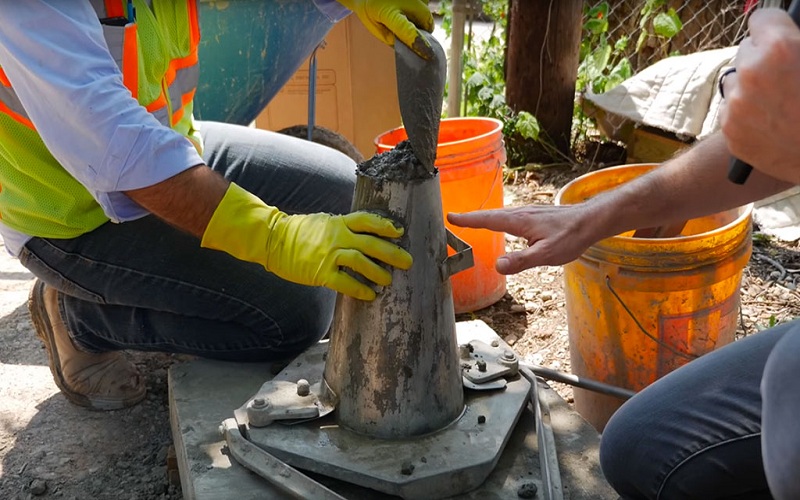What is the slump test of concrete? A detailed explanation of the test procedure

In the world of construction, where precision and durability are paramount, the slump test of concrete using the slump cone test procedure plays a crucial role. This standardized test helps builders and developers assess the workability and consistency of freshly mixed concrete, ensuring that the final construction meets the required specifications and concrete workability test. In this detailed exploration, we will delve into the intricacies of the slump test procedure, shedding light on its significance in the realm of concrete construction and how then affects the efficacy of the concrete workability test.
What is the Slump Test of Concrete?
The slump test of concrete is a widely accepted and standardized method used to measure the consistency and workability of freshly mixed concrete. It is a simple yet effective procedure that aids in assessing the ease with which the concrete can be placed, compacted, and finished without segregation or bleeding, and this is something that can be related to the concrete workability test as well.
Importance of the Slump Test:
Before delving into the nitty-gritty of the slump cone test procedure, let’s understand why the slump cone test procedure is indispensable in the construction industry.
Quality Assurance:
The slump cone test procedure is an integral part of quality control in concrete construction. By evaluating the consistency of the concrete mix, builders can ensure that the final product meets the required strength and durability standards.
Workability Assessment:
Workability is a key parameter in concrete construction, influencing the ease of placement and finishing. The slump test provides valuable insights into the workability of concrete through the concrete workability test, allowing builders to make adjustments to the mix if necessary.
Avoiding Construction Defects:
Inadequate workability can lead to various construction defects such as honeycombing, segregation, and poor surface finish. The slump cone test procedure helps identify potential issues early in the process, minimizing the risk of defects in the final structure.
Concrete Slump Cone:
Central to the slump test procedure is the concrete slump cone, a specially designed instrument that facilitates the measurement of concrete consistency. The cone is made of steel and has a base diameter of 8 inches, a top diameter of 4 inches, and a height of 12 inches. The cone is open at the top and bottom, and the entire assembly is mounted on a rigid non-absorbent surface.
Slump Test Procedure:
Now, let’s delve into the step-by-step procedure for conducting the slump cone test procedure
Preparing the Equipment:
Ensure that the concrete slump cone is clean and free from any previous residues. Place the cone on a smooth, level, and non-absorbent surface. Keep a tamping rod and a measuring tape handy.
Mixing the Concrete:
Prepare a representative sample of the concrete mix to be tested. The sample should be a true reflection of the entire batch. Mix the concrete thoroughly, adhering to the prescribed water-cement ratio.
Filling the Slump Cone:
Place the concrete slump cone on the surface and fill it with freshly mixed concrete in three layers. Each layer should be compacted with 25 strokes of a tamping rod, ensuring uniform distribution and consolidation of the mix.
Striking off the Excess Concrete:
After filling the concrete slump cone during the slump cone test procedure, strike off the excess concrete level with the top of the cone using a trowel. Clean any spillage around the base of the cone.
Lifting the Slump Cone:
Lift the cone vertically and without any lateral or torsional motion. The concrete will settle and subside, forming a conical-shaped mass. This is the slump of the concrete.
Measuring the Slump:
Use a measuring tape to determine the difference in height between the original height of the cone and the subsided height of the concrete. This difference in height is recorded as the slump.
Recording the Results:
Record the measured slump value and compare it with the project specifications. This value provides insights into the workability and consistency of the concrete mix.
Interpreting Slump Test Results:
The measured slump value categorises the concrete mix into different classes, indicating its workability. The following classifications are commonly used:
True Slump (S1):
This represents the general workability of the concrete mix. The slump is in the range of 1 to 4 inches, indicating good workability for most construction applications.
Shear Slump (S2):
Characterized by one-half of the concrete mass sliding down the cone, the shear slump indicates a mix with inadequate cohesion. This type of slump is not desirable for construction.
Collapse Slump (S3):
When the entire concrete mass collapses and loses its shape, it signifies a lack of stability in the mix. A collapse slump is generally not acceptable for most construction purposes.
It’s essential for builders and developers to understand the significance of the slump value in the context of their specific project requirements.
Benefits of the Slump Test in Concrete Construction:
Optimising Mix Proportions:
By conducting the slump test, builders can fine-tune the mix proportions to achieve the desired workability without compromising on strength and durability. This result can be studied from the concrete workability test results.
Minimising Construction Delays:
Identifying workability issues early in the construction process allows for prompt adjustments, minimizing delays and ensuring the project progresses smoothly.
Enhancing Structural Integrity:
Ensuring proper workability through the slump test contributes to the overall structural integrity of the concrete, reducing the likelihood of defects and ensuring long-term durability.
Compliance with Standards:
The slump test is a standardized method endorsed by various construction codes and standards, ensuring that the construction industry adheres to consistent and reliable quality control measures.
Conclusion:
In the world of concrete construction, the concrete slump test stands as a reliable and time-tested method for assessing the workability and consistency of freshly mixed concrete. Builders and developers, as stewards of structural integrity, can leverage the insights provided by the slump test to optimize mix proportions, minimize construction defects, and ensure the longevity of their projects.
As we conclude this detailed exploration of the slump test of concrete and its concrete workability test procedures, it is evident that the significance of this test goes beyond a mere assessment of workability. It is a cornerstone in the foundation of quality control and assurance in the construction industry, ensuring that each structure stands tall with the strength and durability it deserves. By integrating the slump test into their construction processes, builders and developers pave the way for structures that not only meet but exceed the expectations of precision and excellence.





